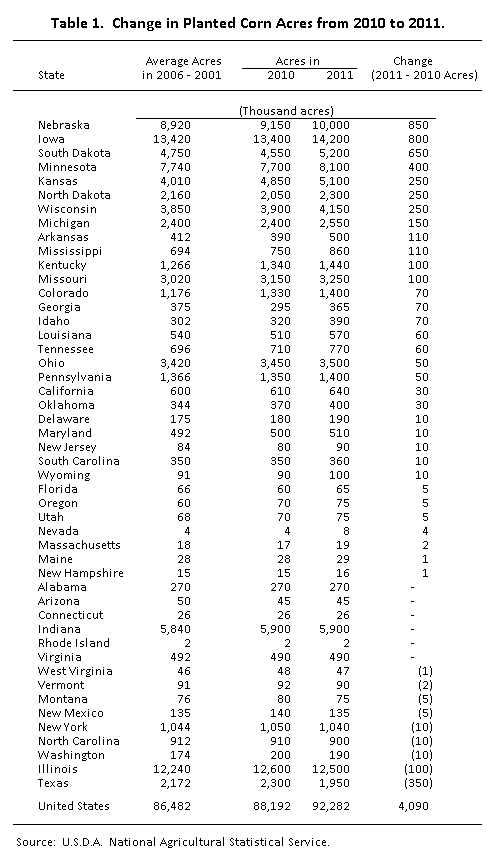Where Did the Corn Acres Come From?
The U.S. Department of Agriculture released its Acreage Report on June 30th and estimated planted corn acres for 2011 at 92 million acres. The 92 million acres is a 4 million acre increase – or a 4.5 percent increase – over 2010 acres of 88 million acres. A complete list of acre changes by state is shown in Table 1. In general, states in the western corn-belt have large increase in acres. Somewhat surprisingly, most states in the eastern corn-belt have not lost acres.

Of the 4 million acre increase, 60 percent occurs in four states: Nebraska (850,000 acres), Iowa (800,000 acres), South Dakota (650,000 acres), and Minnesota (400,000 acres). These four states are located in the western corn-belt where 2011 planting weather has been generally favorable. There are obvious exceptions to this favorable weather in areas where flooding has occurred; however, flooding has not resulted in acreage losses causing state acres to decline below 2010 levels.
Eight states have increases of over 100,000 acres and account for 32 percent of the increase in corn acres: Kansas (250,000), North Dakota (250,000), Wisconsin (250,000), Michigan (150,000), Arkansas (110,000), Mississippi (110,000), Kentucky (100,000), and Missouri (100,000). Generally, these states surround the heart of the corn-belt.
Eastern corn-belt states have not lost acres. For example, Ohio has an increase of 50,000 acres and Indiana has the same acres as in 2010. Both of these states have experienced a wet spring, leading to concerns about whether acres would be prevented from planting or shift to soybeans. While shifting may have occurred, changes did not result in a decline in corn acres.
Illinois has a decline in acres. Illinois acres for 2010 are reported at 12,500,000, a decline of 100,000 acres from 2010 levels. While small, Illinois’s decrease in acres differs markedly from Iowa’s large increase. A wet spring may have contributed to Illinois’ decline. Moreover, many Illinois farmers had poor yields on corn-after-corn in 2010, which may have lead farmers to back off from planting corn-after-corn in 2011.
The state with the largest drop in corn acres is Texas (350,000). Texas has experienced a large increase in cotton acres which may contribute to the corn acre decrease. Drought conditions also may contribute to the corn acre decrease.
Two final observations:
- Western corn-belt farmers appear to have reacted to market signals that project much higher corn returns by planting more corn. It would have been interesting to see if eastern corn-belt farmers would have reacted to the same incentives had spring weather been more conducive to planting. Corn acres may have been higher in the eastern corn-belt had more normal weather occurred, leading to much higher national corn acres than expected.
- Futures prices for corn fell after the release of the June 30th Acreage Report. Part of this decline may be due to actual corn acres being higher than market expectations. While higher than expected, yesterday’s report of 92 million corn acres is the same as made by Joe Glauber for the U.S. Department of Agriculture at the 2011 Agricultural Outlook Conference in February. Even with poor weather in parts of the country, farmers with today’s technologies have a remarkable ability to plant crops.
Disclaimer: We request all readers, electronic media and others follow our citation guidelines when re-posting articles from farmdoc daily. Guidelines are available here. The farmdoc daily website falls under University of Illinois copyright and intellectual property rights. For a detailed statement, please see the University of Illinois Copyright Information and Policies here.







